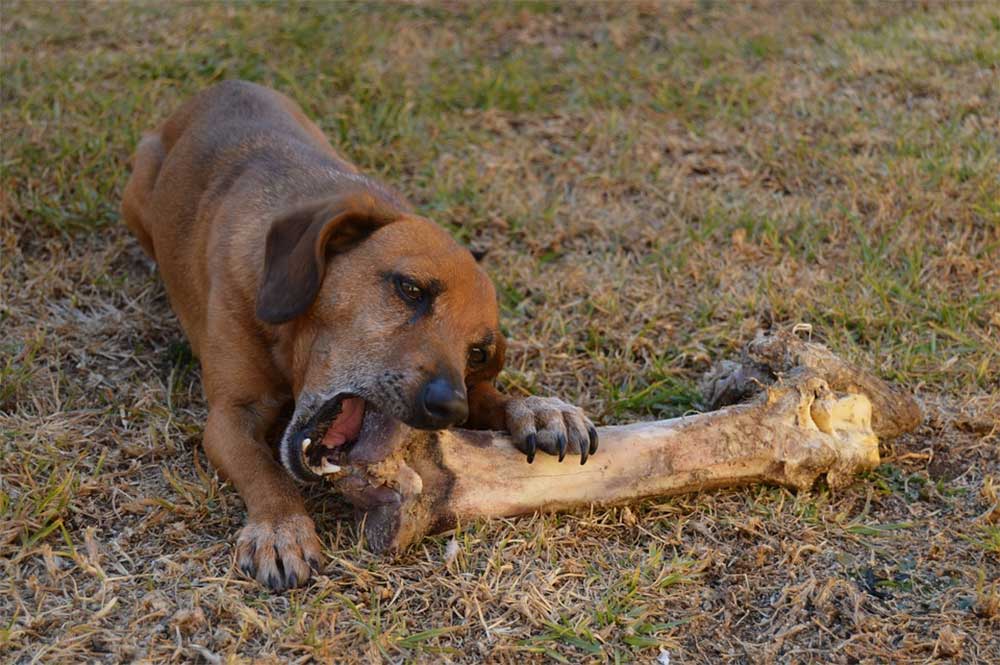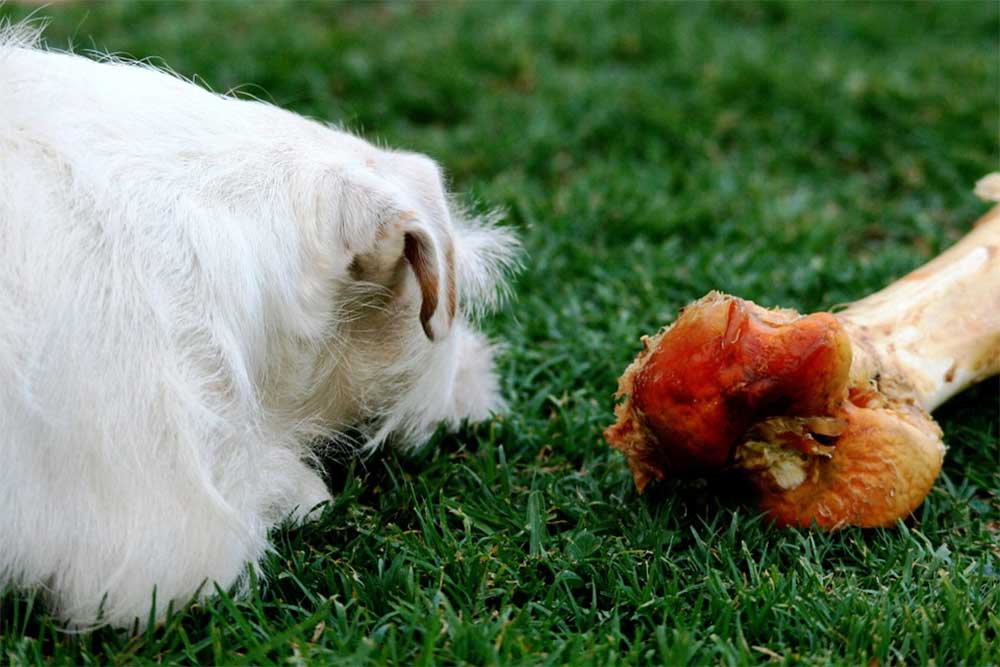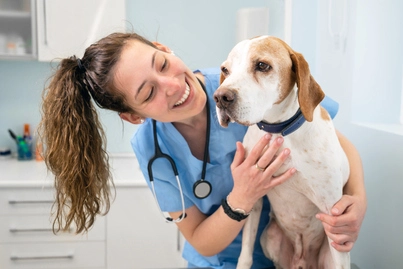There’s no denying that a dog loves a bone. But are they really a match made in doggy heaven?
Lots of people like to treat their furry friends to a tasty bone now and again if they’ve been a particularly good boy.
Bones can provide great chew toys and delicious snacks to keep your dog busy. Plus, they can be super nutritious due to the high levels of calcium and phosphorus they provide.
Depending on the type and size of the bone, though, they could actually be putting your dog at risk of choking or internal damage.

So, how do you know which bones are safe and which ones are not? The best thing to do is educate yourself on what is safe to feed your dog.
If your dog does swallow a bone, and you’re concerned about their well-being. I’ve put together this article as an ultimate guide to feeding your dog bones and what to do if they swallow one.
Keep reading to find out what bones are good, what bones are bad, what may happen if your dog experiences complications, and when to contact your vet.
Connect with a verified veterinarian in minutes. No waiting for appointments or office hours. No high fees. Your pet's health made convenient and worry-free.
Can dogs eat bones?
Dogs can, of course, eat bones; in fact, they love them! But depending on the type of bone and whether it has been cooked or is raw will have a huge impact on what happens next.
Dogs’ digestive systems are able to pass bones naturally due to the acid in their stomach that can dissolve bones.
But, eating too many bones can cause them to suffer with passing bowel movements because the excess calcium they consume makes them constipated.
Raw bones do, of course, come with the risk of raw meat-related illnesses such as salmonella and other harmful bacteria. Fortunately, this does not often happen because the stomach acid in their stomachs is strong enough to kill off any germs.
If your dog is suffering from a bacterial issue like salmonella, here are the symptoms to look out for:
- Stomach pain
- Fever/ high temperature
- Vomiting
- Diarrhea
This is a very rare occurrence, though, so don’t let it put you off-treating your pup to a tasty bone. They can even be nutritionally beneficial to your dog. In fact, eating bones can be a source of calcium and phosphorus and a great source of nutrients when eaten as part of a nutritionally balanced diet.
Here are the types of bones your dog should be safe to chew:
- Uncooked bones – if a bone is cooked, it is more likely to break and fracture, which can cut your dog’s digestive tract. So, the best bone for them to chew is a raw bone. That being said, they must be properly washed to remove any germs and harmful bacteria, like salmonella.
- Large bones – obviously, the bigger the bone, the less likely your dog will be to accidentally swallow. Bones from mammals like cows and pigs. Small bones like ribs are not only easier to swallow but also more likely to break and injure your dog’s insides. A good way to tell if a bone is big enough for your dog is it should be as long as their snout.
- Beef Bones – large cow bones are the safest for your dog to chew because they are denser than most and much less likely to splinter or break.
- Lamb Bones – sheep also have large, dense bones like cows, making them pretty safe to chew
If your dog swallows a raw bone sheep bone, the likelihood is it will pass through them safely, and you won’t have to worry. So, what bones are not safe to chew?
Apart from cow and sheep bones, there aren’t really any other animal bones that are safe for your dog to chew. If they swallow a bone that breaks into sharp fragments, they can tear through your dog’s insides, causing possibly life-threatening internal cuts. A swallowed bone can also cause them to choke or block up their intestines.
Some bones that you should definitely avoid giving to your dog are:
- Chicken and other bird bones – chickens and other birds like ducks and turkeys have very hollow and lightweight bones which break very easily and could break off into fragments inside your dog’s throat, stomach, and intestines.
If you want to add bones to your dog’s diet for their nutritional value, you could grind them up and add them to their usual food. A good option for grinding is chicken neck or other birds.
What to do if your dog has swallowed a bone (cooked or raw)?
If your dog manages to swallow a bone whole or slightly chewed, the first thing you need to do is check their airways and see if they are having any trouble breathing.
Check to see if you can see the bone; if so, you may be able to carefully pull it out yourself. If you can see it but are struggling to remove it, take them to the vet straight away before it moves further into the throat, where it may become even harder to remove.
This may not always be the case. However, your dog may have swallowed a bone and is feeling absolutely fine, this is the best-case scenario, and even then, you can’t be sure there will be no internal damage.
In this instance, keep a good eye on your dog at all times. If they go the rest of the day exhibiting no unusual behavior, they’re probably fine, and the bone will pass naturally.
If this is not the case, the next best thing is that your dog will be sick, and the bone will come up with it. That being said, you should never force your dog to vomit, as this could cause just as much damage.
You should also check your dog’s poop to see if the bone has passed through their body naturally. If that is the case, you should be able to relax.
Will your dog be able to digest the bone?
There are plenty of bones that dogs can safely chew and digest with no need to worry. In fact, even if a dog swallows something they shouldn’t, they are normally able to pass it through their digestive system without the need for you to worry or get the vet involved.
In most cases, your dog’s stomach acid will be able to digest the bone and pass it through the large intestine and poop it out naturally.
However, sometimes bones can be sharp, and impossible for your dog’s stomach acid to dissolve it. Sharp objects inside your dog can result in issues such as perforating the intestine or causing internal bleeding.
So, the best thing to do is make sure you properly dispose of cooked bones and keep trash bags well out of your dog’s reach, or they could end up eating bones without you even realizing.
How long does it take for a dog to digest a bone?

With the majority of softer, smaller-sized bones, your dog should be able to digest a bone within eight to 12 hours of swallowing. That being said, there is no way of fully knowing how long it will take for your dog to pass a bone, as it will depend on if the bone is raw or cooked, the size and shape of the bone, as well as the size and shape of your dog.
It’s always a good idea to keep a close eye on them for at least two days after and contact your vet should they start to exhibit any unusual behaviors or symptoms.
It’s normal to worry if your dog has swallowed a bone, but it’s important not to make any extreme attempts to force them to vomit or pass the bone, as this could cause further damage.
When to speak to a vet
If your dog has swallowed a bone, cooked or not, it’s a good idea to speak to a vet to ask for advice on what to do about it. You may not need to actually take your dog to be seen, but it’s worth double-checking.
In most instances, you will just have to let things naturally take course, but if you notice any of the following symptoms, you should definitely take your dog for a second opinion from a vet.
If your dog is struggling to pass the bone naturally, they will likely exhibit the following:
- Unusual behavior – if your dog is acting differently, such as growling or avoiding cuddles, it may be because they are uncomfortable or in pain
- Loss of appetite and refusing treats
- Drooling, panting, and/or licking lips a lot – dogs often lick their lips as a way of comforting themselves when they’re anxious or in pain, this may be a sign there is a blockage. Equally, they may drool uncontrollably and pant for the same reason.
- Discomfort – refusing to let anyone touch or cuddle them, struggling to get comfortable, stretching as if to move something, lethargic and restless
- Vomiting and/or gagging – an obvious sign that something is wrong; contact your vet immediately.
- Bowel problems – diarrhea, straining, blood in stool
Some of these symptoms are of course, more severe than others, but all should be taken seriously, and should your dog have a blockage, you must seek medical attention as it would appear it is unlikely to pass naturally
Will my dog need surgery to remove the bone?
Surgery will not always be the answer. The vet will do everything they can to resolve the issue in less invasive ways before restoring to surgery.
If they are unable to remove it via the mouth or use other methods such as enemas or other ways of encouraging your dog to pass the bone, then the only option may be to surgically remove it.
Your dog will likely have an x-ray, so the vet can locate the bone and see if there is any internal damage from the bone splintering or rupturing anything.
Hopefully, the x-ray will show that the bone has passed into the large intestine, meaning the majority of it will have been digested and absorbed by the stomach acid. This means it will likely be passed naturally in your dog’s poop, and so the vet will not need to take further action.
If not, the vet may try to remove the bone by bringing it out of the dog’s mouth or by pushing it further into the stomach, so it can pass naturally.
Conclusion
Every dog and every situation is different, and the advice provided here is just general. If it brings you peace of mind, you should contact your vet even if your dog seems completely fine.
While the bone will probably pass naturally all by itself, you never really know exactly what’s going on inside your dog without getting a vet to check what’s going on in there.
Don’t let this article keep you from treating your dog to a big juicy bone from time to time. The right, well-washed bones can be super nutritious for your furry friend.
To be sure what bones will be safe for them to eat, consider consulting with your vet or a veterinary nutritionist to understand the correct bones and how many of them your dog can handle.
If you do plan to feed your dog raw bones, make sure you buy them from official sources such as a butcher or a regulated food brand.
You also need to make sure that you clean the bone very well to remove any germs or harmful bacteria that could upset your dog’s stomach and make them ill.
If you plan to incorporate bones into your dog’s food, you need to be grinding them up thoroughly before mixing them in with their food so they aren’t at risk of getting logged in their throat.
If you’re looking for a nice soft option, easier to grind, try chicken neck or other poultry.

